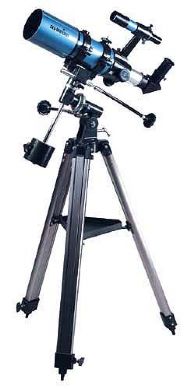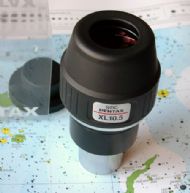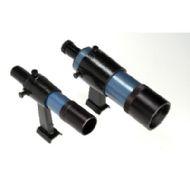 Cromarty Vortex | sitemap | log in Cromarty Vortex | sitemap | log in
|
 |
||
| This is a free Spanglefish 1 website. | ||
Out of the BoxSo you’ve bought yourself a telescope. You’ve waited the inevitable 7 month period before you get a night that is clear, dark and not too cold. You’ve read the manual every single night during those seven months, and know it all inside out. You take the ‘scope out and set it up. You swing it over to one of the very few objects that you can find easily (because you’ve been practising with binoculars before buying a telescope, haven’t you) and look in the eyepiece. It’s just a grey blob. What’s going on here? And why is the focuser so stiff? And why does everything go out of focus at the edge of the field? And why is the view wobbling so much? Ultimately you may ask yourself the ultimate question: Why did I spend £x00 on this thing? – It’s useless! Unfortunately this happens quite often to new telescope owners. Fortunately, there is quite a lot that can be done to improve matters, but you will need to understand some basics of telescope ownership first. First off, when you buy a telescope, if you bought a reputable brand from a proper astronomical retailer the chances are it will be a good one. Telescopes have dropped in price drastically over the last ten years, so that we are now in a position where what we can buy for £300 would have been a major £750 investment a decade ago. But in order to deliver telescope packages to the masses at affordable prices, the accessories included with the ‘scopes can be much lower quality than the optical tube assembly (that’s astro-speak for ‘telescope tube’) itself. The eyepieces will be of old design and cheap manufacture. The diagonal (if the ‘scope is a refractor or Catadioptric) will have a mirror with coatings that are poorly reflective (only say 85% or less), or even worse may be a prism construction that will introduce all sorts of optical errors into the system. The finderscope will probably be a small plastic affair, and the focuser will probably not have been set up or lubricated correctly. In fact you can bet that all moving parts will benefit from a re-lube. The good news is that all of these items are replaceable, and the work involved in re-lubing a focuser or such is not drastic. The even better news is that once you replace those parts with better quality ones, you WILL notice a difference.
I have owned several of these ‘scopes, and soon noticed that by replacing the stock diagonal with a better quality one with a more reflective mirror coating the views got better. A little bit brighter and a little bit clearer. Then I started improving the eyepieces I was using, by changing from the ultra-cheap Kellners that came with the ‘scope, to Plossls or Super-Plossls (moderately priced – about £50 a pop) and guess what? The view improved again, becoming sharper and clearer across the field of view. Later on, when I started investing in very high quality eyepieces with noticeably wider fields (Pentax XL range) the views improved yet again! You really do get what you pay for. The price of the average eyepiece included with a telescope package,
Fixing loose bits and stiff bits requires a different approach. You can’t just throw money at it (well you can, but that’s not always practical) so you may have to overcome your fear of taking things apart and get to work with the screwdriver and Allen keys. Re-lubing a rack and pinion focuser is very easy, and only requires that the work is carried out methodically and slowly. Instructions for this type of job are available all over the Internet. Making a tripod sturdier is also easily done, and only requires minimal technical skills. These tasks will yield noticeable improvements in your equipment and will make observing much more pleasurable and less frustrating. So, with a little extra investment, some time and a small amount of effort, it’s possible to completely transform a poorly performing telescope package into one that will give hours of pleasure. Please note that some telescopes (the expensive ones) will have perfectly adequate accessories bundled with them and will perform superbly out of the box, but more cheap telescopes are sold than expensive ones, and most beginners will buy something in the low to mid price range. I’m not knocking the ‘affordable’ ranges of telescopes out there, like those produced by Celestron, Skywatcher, Meade, and others. The optical tube assemblies themselves can be excellent, but the accessories and quality control stage of the manufacturing process can let them down. That’s when a little pro-active tinkering from telescope owners can drastically improve things. (If the idea of taking things apart frightens you, please DO NOT click here.) Oh, the grey blob may still be a grey blob, but that’s another story…. Click here to go back
Further reading:
|    |
|
 | ||
 Let me use as an example the humble 80mm f5 achromatic refractor telescope. This is not an expensive telescope, and it is readily available in a variety of different telescope packages from several suppliers. It is principally a wide-field low power telescope, but can be capable of more than is expected of it.
Let me use as an example the humble 80mm f5 achromatic refractor telescope. This is not an expensive telescope, and it is readily available in a variety of different telescope packages from several suppliers. It is principally a wide-field low power telescope, but can be capable of more than is expected of it. if bought separately, would be about £25 or less. A good quality Plossl upgrade would cost about £45 to £60 each (noticeable improvement), and a high quality wide field eyepiece like the Pentax XL pictured would cost about £140 second hand, £225 new. How far you can afford to go depends on the individual, but I am only trying to make you see that there is room for improvement even with a very small outlay. You can now get very good highly reflective diagonals with superb mirrors for less than £50, so why settle for the plasticky low-reflectivity one that came bundled with the ‘scope? I mean, you do want your new ‘scope to actually perform well and show you stuff don’t you?
if bought separately, would be about £25 or less. A good quality Plossl upgrade would cost about £45 to £60 each (noticeable improvement), and a high quality wide field eyepiece like the Pentax XL pictured would cost about £140 second hand, £225 new. How far you can afford to go depends on the individual, but I am only trying to make you see that there is room for improvement even with a very small outlay. You can now get very good highly reflective diagonals with superb mirrors for less than £50, so why settle for the plasticky low-reflectivity one that came bundled with the ‘scope? I mean, you do want your new ‘scope to actually perform well and show you stuff don’t you? Replacement finderscopes are available for all telescopes too, and can make it much easier for the novice to find things in the sky. Some of the standard ones supplied with ‘scopes will be tiny 24mm aperture ones that will barely show anything and will not stay aligned with the main ‘scope. A 30mm upgrade is fine for a small ‘scope and will have propr adjustment screws that will hold the finder in alignment very long periods. Little things like this can make all the difference out in the field.
Replacement finderscopes are available for all telescopes too, and can make it much easier for the novice to find things in the sky. Some of the standard ones supplied with ‘scopes will be tiny 24mm aperture ones that will barely show anything and will not stay aligned with the main ‘scope. A 30mm upgrade is fine for a small ‘scope and will have propr adjustment screws that will hold the finder in alignment very long periods. Little things like this can make all the difference out in the field.